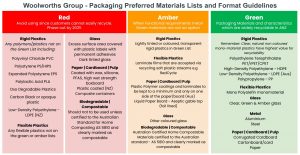In November 2020 Woolworths published its “Sustainability Plan 2025”. One of the goals of Woolworth's sustainability plan is to "make packaging more sustainable".
In an email to the suppliers of Woolworths Director of Buying & Group Replenishment Paul Harker and Group Chief Sustainability Officer Alex Holt, they stated, “Our commitment is to work with you, our trading partners, the government and industry to reduce waste and reduce our business to a circular economy. We have set ourselves the ambitious goal of making all of our own-brand packaging recyclable, compostable or reusable by 2023 and are already working with our own-brand suppliers to achieve this.
"We are also committed to working closely with our retail partners to make our branded packaging more sustainable and working to remove non-recyclable and difficult-to-recycle packaging materials in line with the Australian government's national packaging targets for 2025."
Brooke Donnelly, CEO of the Australian Packaging Covenant Organization, said, “To meet Australia's national packaging targets for 2025, we need a holistic supply chain approach that encourages collaboration and leadership. Today Woolworths demonstrated both of these qualities with the publication of the List of Preferred and Problematic Packaging Materials. The APCO team is proud to have developed a range of public resources to help companies transition to a circular economy for packaging, and members like Woolworths, who share this information with their broad networks, can strengthen and accelerate that transition. "
What that means for suppliers
As part of its commitment, Woolworths has published a "List of Problematic and Preferred Packaging Materials" on Partner Hub that will categorize packaging materials based on recyclability and will work with all suppliers to remove the most difficult-to-recycle materials from their packaging by 2025.
“We created this list in consultation with the Australian Packaging Covenant Organization. We use this list as a guide for our own packaging and would like to share it with all of our suppliers to aid your packaging decisions. We want to work with you to get the most difficult to recycle materials out of packaging by 2025. We hope that this practical and easy-to-understand guide will be a helpful tool in identifying the materials that should be phased out by this point as we work together towards national packaging targets, ”said Mr. Harker and Ms. Holt.
The Partner Hub list contains all of the above information along with supporting material produced by the Australian Packaging Covenant Organization.
“While this feels like long-term goals, it is important that we lead that direction with a reasonable timeframe to understand and identify solutions to problematic packaging to meet that goal by 2025.
“We recommend that you contact us if you have any questions about our sustainable packaging goals and how we can bring about positive change together.
"We will continue to discuss our packaging goals with you on a regular basis and support you in phasing out problematic packaging in the years to come," said Harker and Holt.




